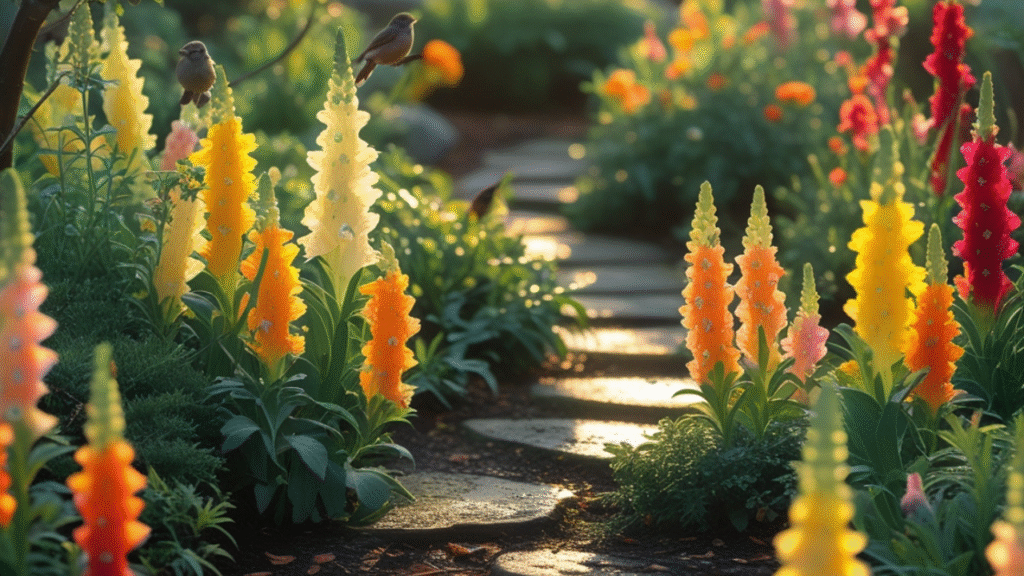
Every spring, as the morning dew sparkles across my garden beds and the world feels fresh and full of promise, I’m reminded why I love to grow snapdragons that spark joy. The very first flower I ever tucked into soil as a young girl was a tall, ruffled snapdragon—bright pink, dancing in the breeze like a fairy in a ballgown. I remember pressing its dragon-shaped blooms between my fingers, fascinated by how they opened and closed like tiny mouths.
Now, decades later, growing snapdragons has become one of my most cherished spring rituals. They’re more than just flowers—they’re symbols of hope, creativity, and resilience. Whether you’re dreaming of armfuls of romantic cut flowers or hoping to add color to a dull corner of your yard, I’m here to guide you with warmth and real-life wisdom.
In this guide, you’ll learn everything you need to know to grow snapdragons successfully—from planting and care tips to overwintering, seed saving, and favorite varieties for continuous blooms. Let’s grow these beauties together, one bloom at a time..
Why Gardeners Love Snapdragons
A Brief History of Snapdragons in Cottage Gardens
Did you know snapdragons (Antirrhinum majus) have been charming gardeners since the Victorian era? Back then, no cottage garden was considered complete without a cluster of snapdragons fluttering beside hollyhocks and sweet peas. Their quirky dragon-mouth blooms enchanted children, while their vertical habit added structure and height to garden borders.
These heirloom favorites originally hail from rocky slopes of the Mediterranean, where they evolved to thrive in full sun and lean soil—making them perfectly suited for U.S. gardens today. I often think of them as a bridge between old-world charm and modern beauty.
Snapdragons’ Symbolism and Color Meanings
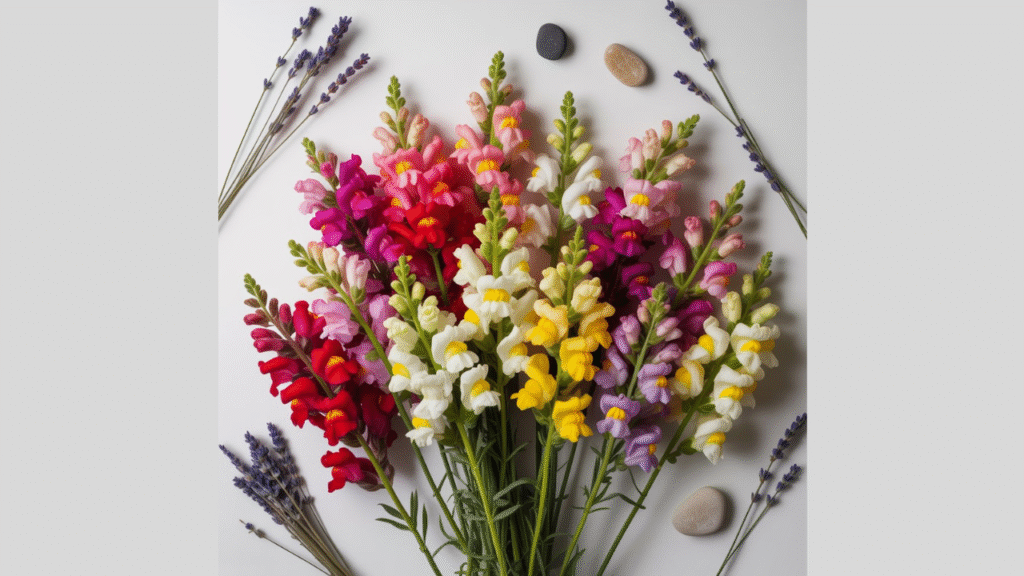
Snapdragons aren’t just pretty faces—they carry deep meanings. Over the years, I’ve found their symbolism makes them even more special when gifting a bouquet or designing a floral arrangement.
Here’s what some of their most popular colors represent:
| Color | Symbolism |
|---|---|
| Red | Passion & Strength |
| Pink | Grace & Gentleness |
| Yellow | Happiness & Positivity |
| White | Purity & Healing |
| Purple | Spirituality & Imagination |
When I arrange snapdragons for friends, I love choosing colors based on what they might need emotionally. A handful of yellow ones on a gray day? That’s like a burst of sunshine in a vase.
Choosing the Right Snapdragons for Your Garden
Best Snapdragons for Cut Flowers vs. Landscaping
Here’s a secret I wish someone told me early on: not all snapdragons are created equal. Some are made to dazzle in bouquets, while others thrive best when filling up flower beds or edging walkways.
Cut Flower Snapdragons (Tall Types):
- Rocket Mix – early-blooming and heat-tolerant
- Madame Butterfly – doubles with ruffled petals
- Chantilly – tall, open-faced blooms with no throat
Landscaping Snapdragons (Dwarf to Mid Types):
- Montego – compact, great for containers
- Snapshot – uniform and bushy, perfect for front-of-bed color
If you’re short on space, the dwarf varieties are gems. But if you’re dreaming of long stems for vases (like I always am), go tall—your scissors will thank you later.
Top Varieties for 2025: From Rocket Mix to Chantilly
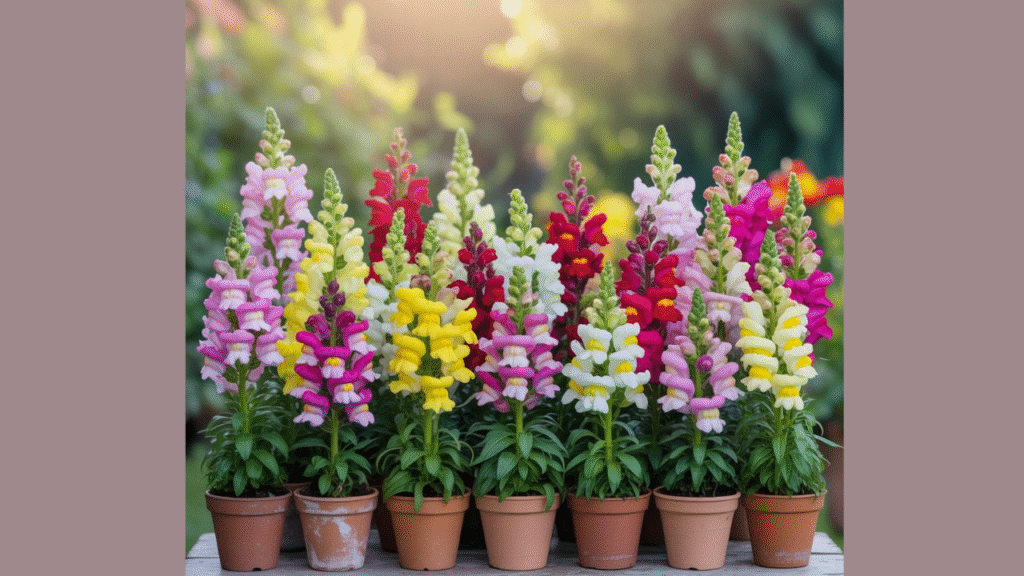
Every year I trial a few new snapdragon varieties in my cut flower patch, and here are the standouts I’ll be planting in 2025:
- Rocket Mix – Ideal for beginners, with strong stems and quick bloom
- Chantilly Light Pink – Elegant and open-faced; a florist favorite
- Madame Butterfly Bronze – Unique color and lush, double blooms
- Potomac Early Yellow – Heat-resistant and long-lasting in vases
- Twinny Peach – A ruffled dwarf variety with a romantic apricot blend
Whether you lean toward classic elegance or playful pastels, there’s a snapdragon variety waiting to win your heart.
When and Where to Plant Snapdragons
Ideal Planting Times by Zone (Spring vs. Fall)
Snapdragons are surprisingly cold-tolerant and love to bloom in cooler weather. For most U.S. zones, here’s a general planting timeline:
- Zones 7–10: Plant in fall for spring blooms. Snapdragons overwinter beautifully with mulch protection.
- Zones 3–6: Start indoors in late winter, then transplant outdoors in early spring, 2–3 weeks before your last frost.
I’m in Zone 6b, and I’ve had snapdragons survive surprise April frosts just fine—tough little petals that they are!
Sunlight, Soil, and Space Requirements
To keep your snapdragons happy:
- Sunlight: 6–8 hours of full sun daily (partial shade in hot climates)
- Soil: Rich, well-draining loam with compost mixed in
- Spacing: 6–12 inches apart depending on variety
Flora’s Tip: Add a handful of worm castings to each planting hole. It gives seedlings a gentle boost of nutrients and helps retain moisture in dry spells.
Starting Snapdragons from Seed (Indoor or Direct-Sown)
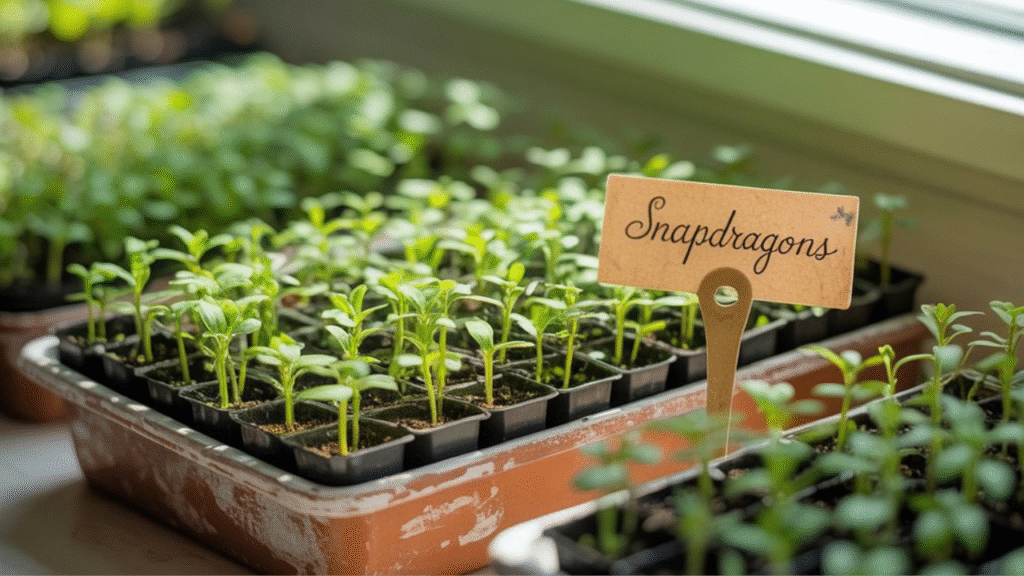
Step-by-Step Indoor Sowing Schedule
I almost always start my snapdragons indoors to get a jump on the season. Here’s my simple schedule:
- 8–10 weeks before last frost: Sow seeds in cell trays (I use a heat mat for quicker germination).
- Lightly press seeds into moist seed-starting mix—do not cover; they need light to germinate!
- Keep at 65–70°F and mist regularly. Germination usually takes 7–10 days.
- Once true leaves appear, gently pot up into 3″ containers.
- Harden off outdoors for a week before transplanting.
Watching those first sprigs of green pop up always fills me with such joy—it’s the promise of spring made real.
Tips for Transplanting Without Shock
- Transplant on an overcast day or in the evening
- Water deeply before and after transplanting
- Handle seedlings by their leaves, not stems
- Mulch immediately to conserve moisture and suppress weeds
I also whisper a little encouragement to each plant as I tuck it in—sounds silly, but I swear they grow better with love.
Direct Seeding: When It Works Best
While I prefer starting snapdragons indoors for stronger stems, direct sowing can work beautifully in mild climates. If you live in Zones 8–10, you can sow seeds directly in the garden in early fall or late winter. Cooler temps give snapdragons time to establish before summer heat kicks in.
Flora’s Quick Tips for Direct Seeding:
- Rake soil to a fine texture
- Surface-sow seeds—do not bury!
- Water gently with a fine mist
- Keep moist until germination (7–14 days)
Direct-sown plants tend to be a bit shorter, but they often bloom earlier and adapt more quickly to their environment. I always scatter a few extra seeds just in case—it’s like sprinkling a little hope into the earth.
Caring for Snapdragons Throughout the Season
Watering, Fertilizing, and Deadheading Tips
Healthy snapdragons thrive on consistency. Here’s how I keep mine happy all season long:
- Watering: 1–2 inches per week; water early in the morning to avoid mildew
- Feeding: Use a balanced organic fertilizer every 2–3 weeks
- Deadheading: Remove spent blooms to encourage repeat flowering
Flora’s Tip: I pinch back the top few inches of young plants to encourage bushier growth—it may feel ruthless, but it works wonders!
How to Stake Tall Snapdragons Without Damage
Tall varieties like Rocket or Chantilly can get top-heavy, especially after a rain. To prevent flopping:
- Stake early while plants are still small
- Use bamboo stakes or soft garden twine
- Tie loosely in a figure-8 pattern to avoid stem bruising
A little support goes a long way in keeping your snapdragons upright and photo-ready!
Dealing with Summer Heat or Drought Stress
Snapdragons prefer cool temps and may struggle in midsummer. If your blooms start looking tired:
- Mulch generously to keep soil cool
- Provide afternoon shade with row covers or taller plants
- Water deeply, not frequently
If your region gets scorching summers, try a second sowing in late summer for fall blooms. I call this my “snapdragon encore”—a second round of beauty before the frost.
Common Problems & Easy Fixes
Wilting, Yellow Leaves, or No Blooms?
These issues are often tied to overwatering, poor soil, or too much heat. Here’s how I troubleshoot:
- Wilting despite watering? Check for root rot.
- Yellow leaves? May signal nutrient deficiency or poor drainage.
- No blooms? Try pinching young plants or boosting light exposure.
I always start with a soil test when things go wrong—your plants will tell you what they need if you listen.
Snapdragons and Rust, Mold, or Aphids
Snapdragons are tough, but they’re not immune to pests or disease:
- Rust (orange spores on leaves): Remove infected foliage and apply neem oil.
- Gray mold (Botrytis): Improve airflow and avoid overhead watering.
- Aphids: Spray with insecticidal soap or release ladybugs.
Flora’s Reminder: It’s okay to lose a few plants. Every garden has hiccups—what matters is learning and trying again.
Disease Prevention Through Spacing and Care
Most disease issues can be avoided with smart planning:
- Space plants at least 6 inches apart
- Water at the base—never from overhead
- Rotate beds yearly to prevent soil-borne pathogens
Think of these habits as preventative self-care for your garden. A little attention now saves a lot of frustration later.
Harvesting Snapdragons for Cut Flowers
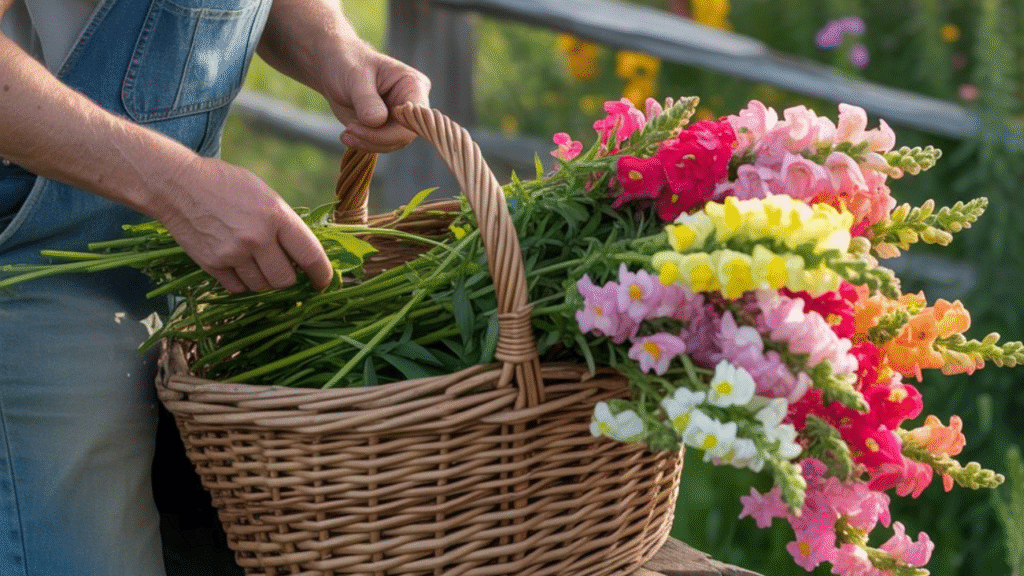
Best Time to Cut for Long Vase Life
For the longest-lasting blooms, harvest snapdragons when the bottom third of flowers are open and the rest are still buds. Use sharp, clean snips and harvest in the cool of morning.
They’ll continue opening in the vase, giving you a full display within a day or two.
How to Condition Snapdragons Post-Harvest
- Strip lower leaves to prevent rot
- Place stems in lukewarm water immediately
- Allow them to rest in a cool, dark room for 4–6 hours
Snapdragons are phototropic, meaning they bend toward light. Store them upright in tall buckets to keep stems straight—your vase arrangements will thank you.
Overwintering and Saving Seeds
Can Snapdragons Survive the Winter?
In Zones 7 and up, yes—snapdragons can survive winter with protection!
- Cut plants back by half after blooming
- Mulch heavily (4 inches) around the base
- Avoid soggy soil in winter months
Even in colder zones, fall-planted snapdragons often bounce back after winter dormancy—like old friends returning in spring.
How to Collect and Store Snapdragon Seeds
Let a few flower stalks dry on the plant at season’s end. When the pods turn brown and papery:
- Snip off seed pods and place in a paper bag
- Label and store in a cool, dry place
- Sow within one year for best germination
Collecting your own seeds adds a sweet sense of legacy—your next garden grows from the love you sowed this season.
Personal Gardening Notes: My Experience with Snapdragons
My First Snapdragon Success and What I Learned
I still remember my first full row of snapdragons—Chantilly Peach and Rocket Rose, blooming side by side. I had no idea what I was doing, but I watered them every morning, whispered encouragement, and hoped for the best.
What bloomed was more than flowers—it was confidence. The joy of cutting that first bouquet brought tears to my eyes.
Here’s what I learned:
- Trust your instincts
- Watch your plants—they’ll tell you what they need
- Failures are just invitations to try again
Favorite Varieties for Continuous Blooms
Some snapdragons just don’t quit. These are my reliable go-tos for long, cheerful bloom seasons:
- Madame Butterfly Bronze
- Chantilly Light Pink
- Rocket Mix
- Twinny Appleblossom
Rotate these through spring and fall plantings for a garden that never feels dull.
Final Thoughts: Why Snapdragons Deserve a Spot in Every Garden
If I could only grow one flower every spring, it would be snapdragons. They’re reliable, joyful, and deeply rewarding—from the first green shoots to the last snip of fall.
Whether you’re planting your first seed tray or dreaming of overflowing vases, know this: growing snapdragons isn’t just about flowers—it’s about beauty, patience, and connection. They teach us to trust the process, to care gently, and to celebrate small victories.
So go ahead—choose your favorite colors, prepare your soil, and get planting. I’ll be right there with you in spirit, cheering on every bloom.
With love and dirt under my nails,
Flora Lane
FAQs About Growing Snapdragons
Do Snapdragons Come Back Every Year?
Snapdragons are technically tender perennials, but most gardeners grow them as annuals. In Zones 7–10, they can survive winter with mulch and return in spring. Elsewhere, replant each year or save seeds for the next season.
Can I Grow Snapdragons in Pots or Containers?
Absolutely! Choose dwarf varieties like Snapshot or Twinny, and make sure your pot has:
- Full sun exposure
- Excellent drainage
- At least 8 inches depth
Add a splash of trailing alyssum or dusty miller around the base for a charming container combo.
Are Snapdragons Safe Around Pets?
Snapdragons are non-toxic to cats and dogs, according to the ASPCA. Still, it’s best to keep curious nibblers away—especially puppies who dig up your beds (ask me how I know ).


Pingback: How to Build a Beautiful Bouquet with Cut Flower